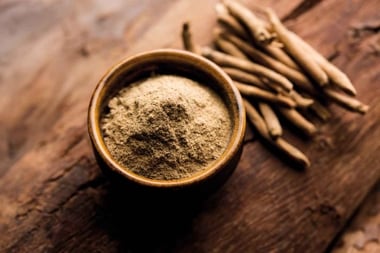Good Sugars, Bad Sugars

Our society's collective sweet tooth is an adaptive response. It goes back to caveman days and it's what encourages us to eat foods that are high in energy and nutrients.
Our society’s collective sweet tooth is an adaptive response. It goes back to caveman days and it’s what encourages us to eat foods that are high in energy and nutrients. The problem is that the refinement of sugar has removed all the beneficial nutrients, enzymes and other plant compounds that give naturally sweet foods their goodness.
In small amounts, sweeteners cause no problems to most people, especially when they are eaten in natural forms like fruit. Large amounts of sugar on a regular basis however, cause insulin resistance, a state in which the body does not respond to the hormone responsible for controlling blood sugar correctly.
Insulin resistance is a significant step towards adult onset diabetes. The resulting chronic high blood sugar is usually converted to fat, leading to obesity. Of course insulin is a hormone with many factors affecting it, not just sugars in the diet. Things like binge and starve eating patterns (including eating only one or two meals a day), stress and lack of sleep can all cause problems with blood sugar, which lead to the seldom-diagnosed hypoglycemia.
We might not even be aware of how much sugar we consume. Soft drinks are the form in which most sugar is consumed. Sugar is also added to hamburgers to reduce shrinkage and add juiciness, to breading in deep fried foods or to give frozen fish a sheen. It is commonly added to canned and frozen fruit and vegetables to maintain color and juiciness.
Consumers have become more aware of food labels in which ingredients have to be listed in order, largest amount on down to the lowest, so manufacturers have been listing several types of sugars instead of one. This way, the sugars can be further down on the ingredient list, even though the total amount is quite high.
A Sugar is a Sugar is a Sugar
White sugar, "brown sugar" and molasses do not differ in health value, only in taste. They all come from the same source, either sugar cane or sugar beet. The two types are used pretty much interchangeably. Though some individuals who are particularly sensitive or allergic to one or the other can tell the difference, most people can’t. White sugar is the final result of processing and is 99.9-per-cent pure sucrose (a chemical).
In some places, brown sugar is made by cutting short the refinement process and leaving some molasses in the sugar for taste and color. In others, they add caramel. Sometimes brown sugar is produced by processing white sugar with animal bone charcoal to brown it.
Raw sugar is often called "unrefined" or "natural" sugar, but that is a misnomer. True "raw" sugar is illegal for sale, since it contains sand, soil, mold, bacteria, yeast, lice and other impurities. Turbinado sugar is raw sugar washed just enough to meet filth tolerances, but might still have impurities. Often what is sold as raw sugar is white sugar with cane or beet pulp or molasses added.
Molasses is the crushed up plant material with or without some of the sugars removed. It has some nutrients, but not really a significant amount. Its real value is its characteristic taste and a mild antioxidant quality that can delay the spoilage of food to which it is added.
The quality of molasses depends on whether it is the primary product or a byproduct of sugar production. Good, unsulfured molasses is made with a 200-year-old process using mature cane and aged before selling. Sulfured molasses is a byproduct from sugar production using green cane. It contains the residue of sulfur extraction of the sugar. Blackstrap molasses is the lowest grade of molasses–the remaining product when all the profitable material has been extracted. It can contain concentrated contaminants.
Cheaper, But Not as Sweet
Cornstarch treated by heat or enzymes to make dextrose, maltose, corn syrup corn sugar, lump sugar and crystalline dextrose has also increased in use. These sugars are cheaper than cane or beet sucrose, but not as sweet. They are used as supplements to sucrose in processed foods to bring costs down; add color and flavor to baked goods; prevent oxidation; retain the bright color in fruit preserves, cured meat and ketchup; and inhibit crystallization of sucrose. The widespread use of these sweeteners may be the cause for the increased incidences of corn allergies.
Honey symbolizes natural and healthful foods; people with sensitivities are less likely to react to honey than to sugar. In a raw state it contains some beneficial enzymes and nutrients, but the nutrients left in honey depends greatly on the method of extraction used. Honey from a reputable source can be a healthy replacement for refined sugar, but there are a few things you should be aware of.
Honey in the comb is no guarantee of buying raw honey, since treated honey is frequently put into clean, empty combs. Botulism spores sometimes appear in low enough concentrations that they will not bother healthy adults, but children under two and anyone with a compromised immune system should not eat honey. Honey combs may also be fumigated by toxic chemicals, leaving pesticide and herbicide residues in the honey. Nectar from toxic plants such as azalea or ragweed can introduce carcinogens.
Maple syrup was highly prized by settlers in North America as a sweetener when refined sugar was hard to come by. The syrup is the concentrated sap of the sugar maple tree. Now that sugar has become hard to avoid rather than to obtain, maple syrup is still prized for its unique flavor. In that respect, it is in the same category as molasses and honey; useful in small amounts for its flavor, but not any more virtuous.
Grading of the syrup can be confusing because it is based on color and clarity rather than on quality. Artificial maple syrup made from cane sugar has become more common than the real thing, though the maple syrup industry has been taking countermeasures for widespread mislabeling. Maple syrup from the US might also contain some artificial antibacterial from pellets used to keep bacteria from closing the tap holes in the tree and slowing the sap flow. Use of these pellets is illegal in Canada.
Crystalline fructose was very popular in the late 1970s and still sometimes used today. It and high fructose corn syrup are both much sweeter than ordinary table sugar and thus can reduce the amount of sugar used. These sugars seem to have a slower uptake and more moderate blood sugar response, so they may be better for diabetics, but all the other health claims made for these have been proven false.
Good and Bad Alternatives
The most commonly used artificial sweeteners are aspartame, sold under the trade names Equal and Nutrasweet, and sucralose, sold under the trade name of Splenda. Artificial sweeteners can increase desire for sweets, deaden tastebuds and induce insulin resistance, a large step towards adult-onset diabetes.
Aspartame causes additional problems because of its chemical breakdown. A molecule of aspartame consists of two amino acids (phenylalanine and aspartic acid) linked by a molecule of methanol, the alcohol found in antifreeze. At 30C (86F), lower than body temperature, the three components come apart and each has distinctive effects. The methanol is metabolized in your body to formaldehyde and then to formic acid. Both of these are very potent metabolic poisons.
Phynylalanine and aspartic acid both mimic brain neurotransmitters. They can disrupt the balance of these chemicals, causing depression, seizures, memory problems and problems with concentration and learning. They may also be a factor in the development of neurodegenerative disorders like Alzheimer’s, Parkinson’s and ALS (Lou Gherig’s disease), as well as multiple sclerosis.
The final answer in low-calorie sweeteners just might be the herb stevia. There is not much research done on this herb because of resistance to its marketing by the sugar industry, but it does look promising. Stevia is the powdered leaf of the green plant. The leaf is much sweeter than table sugar, without the bitter aftertaste that chemical artificial sweeteners can have. There is some evidence that stevia can regulate blood sugar, kill mouth bacteria and improve digestion. Because of its scarcity though, caution should be taken that the sweetener is from a reputable company.
Enjoy your sweets as an occasional treat, rather than something needed daily, and enjoy the natural savor of healthy whole food. You’ll soon lose the sugar craving.




